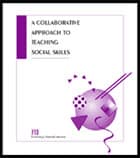 A Collaborative Approach to Teaching Social Skills
A Collaborative Approach to Teaching Social Skills
$79.00
#CAT369
Authors: Cynthia Warger and Robert Rutherford
ISBN 1-931311-01-3
Use this video-based training package to learn how to teach critical classroom social skills to students (K-8) in inclusive classrooms and schools. The package offers practical instructional strategies for educators–teachers, special educators, school psychologists, social workers, guidance counselors, and teacher educators–who are working alone or in collaborative partnerships to develop social skills in all students. A special section provides strategies for teaching social skills to students with behavioral difficulties.
The 300-page manual tells you how you can infuse social skills into your instruction to ensure success. The manual includes blackline masters of overheads, sample activities from teachers who have successfully piloted the approach, assessment forms, and teacher-developed scope and sequence materials for the most commonly taught social skills.
An accompanying videotape (approximately 60 minutes) shows how teachers across the country have used the social skills approach with diverse student populations–including students in rural, suburban, and urban areas; students with and without disabilities; students with diverse cultural backgrounds.
Perfect for use in inservice workshops or university methods courses! The manual and accompanying video (VHS format) have been successfully field tested in school districts and university-based teacher preparation programs.
Table of Contents
A Collaborative Approach to Teaching Social Skills
1. A Collaborative Approach to Teaching Social Skills 1
2. Getting Started: An Overview 9
3. The Teaching Social Skills Program 27
4. Facilitator’s Guide: Teaching Social Skills Program with Sarup Mathur 53
5. Teaching Social Skills in the Classroom 79
6. Implementing A Collaborative Approach to Teaching Social Skills 91
References 99
Appendices
A. Rationale for Social Skills Training 107
B. Applying a Collaborative Model 109
C. Collaborative Structures 111
D. Definition of Social Skills 113
E. Types of Social Skills 115
F. A Collaborative Approach to Teaching Social Skills Framework 117
G. Instructional Strategies for Teaching Social Skills 119
H. Social Competence Screening Form 121
I. Self-Report Form 123
J. Student-Social Skills Matching Form 127
K. Accepting the Answer No 131
L. Compromising with Peers 133
M. The Teaching Social Skills Model 135
N. Selected Social Skills 139
O. Assumptions of the Teaching Social Skills Program 141
P. Students with Withdrawn Behaviors 143
Q. Students with Immature Behaviors 145
R. Students with Aggressive Behaviors 147
S. Defining Social Skills 149
T. Behaviors or Not Behaviors Activity 151
U. Recording Tools 153
V. Guidelines for Event Recording 155
W. Guidelines for Duration Recording 157
X. Guidelines for Time Sampling 159
Y. Time Sample Recording 161
Z. Time Sample Recording—Reliability 163
AA. Following Directions 165
BB. Following Directions—Steps 167
CC. Criteria for Modeling 169
DD. Self Control 171
EE. Sample Record Card for Asking Questions 173
FF. Changing Conditions or ABC Design 175
GG. Multiple Baselines 177
HH. First Grade Social Skills with Beth Yglesias and Cleland Strickland 181
II. Lesson Plan: Waiting One’s Turn with Wendy Foss and Koleen Martinez 191
JJ. Lesson Plan: Fairy Tales with Beth Yglesias 193
KK. Sample Lesson Plans with Nora Miller, Beth Yglesias, Debbie Guedry,
Frankie Day, Tot Swanson and Mary Nell Dominique 203
LL. Workshop Agenda 225
MM. Entry Points for Identification 227
NN. Listening 229
OO. Conflict Resolution with Beth Yglesias and Debbie Guedry 235
PP. Respect Exercise 239
QQ. Sample Activity 253
RR. Teaching Social Skills Log 255
SS. Collaboration Log 257
TT. Teaching Listening Skills with Jan Greenwell 259
UU. Field-based Social Skills Training for Preservice Educators with
Jo Cleland and Peggy George 273
VV. What Makes Collaboration Difficult In a Social Skills Context 281
WW. The Time Issue: Ideas 283
XX. Skip 285
YY. Following Directions 287
ZZ. Social Skills Baseline Form 299
Read an excerpt of this publication in PDF.
